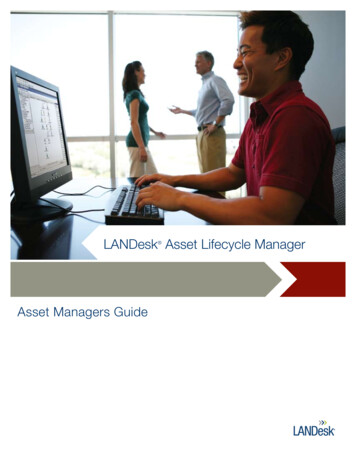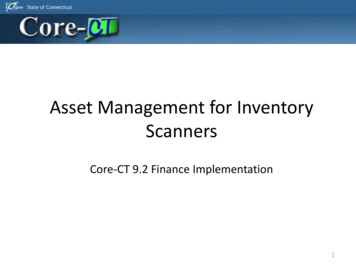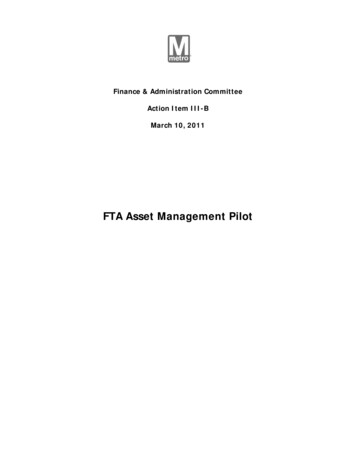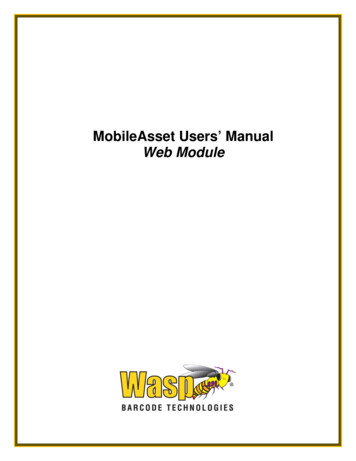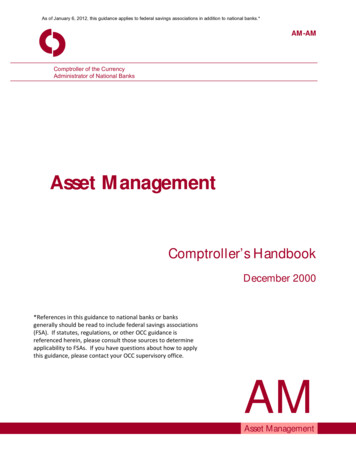
Transcription
As of January 6, 2012, this guidance applies to federal savings associations in addition to national banks.*AM-AMComptroller of the CurrencyAdministrator of National BanksAsset ManagementComptroller’s HandbookDecember 2000*References in this guidance to national banks or banksgenerally should be read to include federal savings associations(FSA). If statutes, regulations, or other OCC guidance isreferenced herein, please consult those sources to determineapplicability to FSAs. If you have questions about how to applythis guidance, please contact your OCC supervisory office.AMAsset Management
As of January 6, 2012, this guidance applies to federal savings associations in addition to national banks.*Asset ManagementTable of ContentsIntroductionIndustry CharacteristicsProducts and ServicesRegulatory FrameworkRisksRisk ManagementOCC Supervisory Processes135172136Examination Procedures4344475471General ProceduresQuantity of RiskQuality of Risk ManagementConclusionsAppendixA. Operating a Risk Management UnitB. Asset Management Profile — Sample FormatReferencesComptroller’s Handbook757783iAsset Management
As of January 6, 2012, this guidance applies to federal savings associations in addition to national banks.*
As of January 6, 2012, this guidance applies to federal savings associations in addition to national banks.*IntroductionThe Office of the Comptroller of the Currency (OCC) defines assetmanagement as the business of providing financial products or services to athird party for a fee or commission. The supervision of asset managementactivities is an important component of the OCC’s safety and soundnesssupervisory framework. This booklet provides an overview of the assetmanagement business, its risks, and sound risk management processes. It alsodescribes the OCC’s supervisory philosophy and processes, and how they areapplied to the asset management activities of national banks, includinglimited purpose trust banks.The OCC is publishing a series of asset management booklets, of which thisbooklet is the lead. Examiners use asset management booklets whenreviewing asset management products and services; national banks use thebooklets to help them manage these products and services. The examinationprocedures herein are designed for use by OCC examiners in large banksand, as needed, in community banks. In community banks, the proceduressupplement the “Community Bank Fiduciary Activities Supervision” bookletof the Comptroller’s Handbook.In addition to the asset management booklets, other booklets from theComptroller’s Handbook provide important supervisory guidance applicableto asset management activities. They are referred to throughout this booklet,and a list of them is provided on the “References” pages.Industry CharacteristicsFor the past quarter century, the asset management business has been rapidlygrowing and evolving, helped by demographic, technological, regulatory,and global economic trends. The traditionally conservative fiduciary businessof national banks is undergoing a transition to a dynamic and highlycompetitive asset management business.Hallmarks of the evolution of the asset management industry include: Tremendous product demand from an increasingly sophisticated andglobally oriented client;Comptroller’s Handbook1Asset Management
As of January 6, 2012, this guidance applies to federal savings associations in addition to national banks.* Intense competition from other financial service providers, such asinvestment companies, insurance companies, and brokerage firms; Expansion of bank powers through the removal of most of the GlassSteagall Act restrictions and other financial modernization initiatives; Rapid globalization of financial instruments and markets; Significant industry consolidation through mergers and acquisitions; and The development of complex and rapidly changing product distributionand information technologies.Asset management activities expose national banks to an increasingly broadrange of risk factors and thus reinforce the importance of maintaining soundrisk management processes. National banks must have the ability toeffectively identify, measure, control, and monitor risks in their assetmanagement businesses. Because most of these risks arise from off-balancesheet activities, they are not easily identified and measured using traditionalfinancial reporting systems.Many national banks are marketing new and complex financial products andservices to strengthen their competitiveness, meet growing customer demand,and generate additional sources of noninterest income. Declining interestmargins and the desire for a stable and diversified revenue stream havecaused banks to look for ways to increase the level and source of noninterestincome. Asset management products and services are filling this need andhave become, or are becoming, a significant contributor to total revenue andthe overall profitability of many national banks.National banks have made strategic acquisitions of, and alliances with,domestic and international financial services companies, such as brokerage,insurance, investment banking, and investment advisory firms. Thesetransactions are driven by a need to expand or fill product lines; extenddistribution channels and market penetration; improve cost efficiency; andacquire additional expertise, talent, and technology. At the same time, otherbanks have made strategic decisions to focus on traditional fiduciary lines ofbusiness.Asset Management2Comptroller’s Handbook
As of January 6, 2012, this guidance applies to federal savings associations in addition to national banks.*Products and ServicesAsset management activities include traditional fiduciary services, retailbrokerage, investment company services, and custody and security-holderservices. The distribution channels for asset management products andservices vary according to the size, complexity, financial capacity, andgeographic characteristics of each institution. They may be provided in acentralized division of the bank, through several divisions in differentgeographical locations, in bank operating subsidiaries and other affiliates, andthrough arrangements with unaffiliated third parties.For example, a large banking company may establish an asset managementgroup consisting of several interlocking divisions, branches, subsidiaries, andaffiliates that provide a broad range of asset management products andservices on a global scale. A small community bank may simply operate aseparate “trust” division that provides traditional fiduciary services and mayalso provide access to retail brokerage services through an unaffiliated thirdparty vendor located within the bank’s branch network.Product demand and technological advancements are rapidly changing thestructures of financial markets and the means of product distribution. Theglobalization and deregulation of financial markets have compelled manylarger banks to offer products and services in a number of markets around theworld. The Internet is but one example of a technology that is altering theproduct distribution landscape for all banks and creating challenging risks forthe industry.In response to the demand from and competition for the wealthy individualclient, many national banks offer what has been traditionally referred to as“private banking services.” In many respects, private banking is the samebusiness today that it was in the past – the high-quality and confidentialprovision of finance-related services to wealthy individuals and theirbusinesses. Today, private banking is one of the fastest growing segments ofthe financial services industry. The growth in demand for these services hasbeen driven by the tremendous generation of wealth and significanttechnological advancements achieved over the past decade. Private bankingservices will be addressed in the “Personal Financial Services” booklet of theComptroller’s Handbook, which has yet to be published as of this booklet’spublication date.Comptroller’s Handbook3Asset Management
As of January 6, 2012, this guidance applies to federal savings associations in addition to national banks.*Fiduciary ServicesFiduciary services offered by national banks have evolved into acomprehensive and integrated selection of financial products and servicesthat permit banks to compete with other financial service providers, such asbrokerage firms, investment companies, investment advisers, and insurancecompanies. Traditional fiduciary services include personal trust and estateadministration, retirement plan services, investment management services,and corporate trust administration.National banks also provide other fee- or transaction-based fiduciary-relatedservices, such as financial planning; cash management; tax advisory andpreparation; and advice on, and execution of, financial risk managementproducts, such as derivatives. Fiduciary services are provided throughinternal bank divisions, subsidiaries (including separately chartered trustbanks), other affiliates, and third-party service arrangements.The increasing importance of fee income is a key factor in the evolution offiduciary services. Rapid technological advances, state legislatures adoptingreasonable compensation statutes, and a management focus on generatingadditional revenue sources have enabled banks to base the prices of theirproducts and services on actual delivery costs and internal risk/returnprofitability standards. Competitive and innovative fiduciary products andservices give banks the opportunity to increase and diversify revenue streams.Custody and Security-holder ServicesNational banks have long provided custody and security-holder servicesincidental to the delivery of other fiduciary services. In recent years, theinstitutional side of the custody business has become concentrated in a fewlarge banking companies through mergers and acquisitions. Related servicesinclude custody, safekeeping, payment, settlement, record keeping, transferagent, securities lending, and other reporting functions for securityinstruments, such as equities, debt, and related hybrids. Banks may serve in atrustee or agent capacity with or without investment discretion authority.These services may be provided for the issuer or the holder of securities andinclude both domestic and international clients. Refer to the “CustodyServices” and “Corporate Trust“ booklets of the Comptroller’s Handbook(neither booklet has been published as of this booklet’s publication date) formore information about these activities.Asset Management4Comptroller’s Handbook
As of January 6, 2012, this guidance applies to federal savings associations in addition to national banks.*Retail Securities BrokerageRetail securities brokerage is an important and growing line of business formany banks, particularly large banking companies. Banks offer retailbrokerage services to meet their clients’ investment needs, maintain andstrengthen customer relationships, and generate fee income. Retail brokerageservices include the sale of equities, fixed-income products, mutual funds,annuities, cash management sweep accounts, and other types of investmentinstruments. Service capacities range from full-service brokerage thatprovides clients investment advice to discount brokerage that provides tradeexecution on an unsolicited basis. Large banking companies utilize their retailbanking network as a marketing mechanism for both proprietary andnonproprietary investment products.Investment Company ServicesNational banks have long provided financial services to investmentcompanies, including registered and unregistered companies. The provisionof investment company services is now a strategic line of business andincome generator for many banks. Investment company services includefund administration, investment advisory, custody, and transfer agencyactivities. Financial subsidiaries of national banks are permitted to underwriteand distribute shares of registered investment companies.Regulatory FrameworkAs the primary regulator of national banks, the OCC has the responsibility forevaluating the consolidated risk profile of a bank, including risks associatedwith asset management. National banks may, however, provide assetmanagement products and services that are functionally regulated by anotherfederal or state agency. Such agencies have the primary responsibility tosupervise the functional activity (such as securities brokerage or investmentadvisory services) and interpret and enforce applicable laws and regulationsunder their jurisdiction.The OCC is responsible for assessing the potential material risks posed to thebank by functionally regulated activities conducted by the bank or afunctionally regulated entity, and for determining compliance with applicablelegal requirements under the OCC’s jurisdiction. A key part of thisComptroller’s Handbook5Asset Management
As of January 6, 2012, this guidance applies to federal savings associations in addition to national banks.*responsibility is evaluating a national bank’s systems for managing risks that afunctionally regulated activity poses to the bank. The OCC’s policy onfunctional supervision will be included in the “Bank Supervision Process”booklet of the Comptroller’s Handbook, which has yet to be published as ofthis booklet’s publication date.For a list of the primary laws and regulations applicable to asset managementactivities, see this booklet’s “References” pages.Fiduciary PowersThe statutory authority for national banks to exercise fiduciary powers is 12USC. 92a, Trust Powers. Under section 92a(a) the OCC is authorized topermit national banks, when not in contravention of state or local law, toexercise eight expressly identified fiduciary powers and to act in any otherfiduciary capacity in which state banks, trust companies, or othercorporations that come into competition with national banks are permitted toact under the laws of the state in which the national bank is located. Undersection 92a(b), whenever state law permits state institutions that competewith national banks to exercise any or all of the fiduciary powers listed insection 92a(a), a national bank’s exercise of those powers is deemed not tobe in contravention of state or local law under section 92a.Section 92a does not expressly address the extent to which a national bankmay conduct a multi-state fiduciary business. Many bank holding companiesconduct multi-state fiduciary operations through separate bank or trustcompany subsidiaries chartered in different states. While the Riegle-NealInterstate Banking and Branching Efficiency Act of 1994 facilitated theconsolidation of multi-state fiduciary operations by permitting interstate bankmergers, it did not define the scope of a national bank’s multi-state fiduciaryauthority.The OCC has since issued three interpretive letters that address multi-statefiduciary operations. OCC Interpretive Letter 695, dated December 8, 1995,concluded that a national bank with its main office in one state may act in afiduciary capacity in any other state that permits its own in-state fiduciaries toact in that capacity, including at non-branch trust offices. In InterpretiveLetters 866 and 872, dated October 8, 1999, and October 28, 1999,respectively, the OCC further clarified that a national bank that acts in afiduciary capacity in one state may market its fiduciary services to customersAsset Management6Comptroller’s Handbook
As of January 6, 2012, this guidance applies to federal savings associations in addition to national banks.*in other states, solicit business from them, and act as a fiduciary for customerslocated in other states. Please refer to the full text of these letters foradditional information concerning multi-state fiduciary operations.Fiduciary powers may be authorized for, and conducted in, a full-servicecommercial bank, a subsidiary, or a special purpose bank whose charter islimited to fiduciary activities. In order to exercise fiduciary powers, a nationalbank must submit an application to the OCC and obtain prior approval fromthe agency; in certain circumstances, it may be required merely to file anotice with the agency. The OCC generally approves fiduciary applications ifthe bank is operated in a satisfactory manner, the proposed activities complywith applicable law, and the bank retains qualified fiduciary management.OCC procedures governing the review and approval of fiduciary applicationsare set forth in 12 CFR 5.26, Fiduciary Powers, and the Comptroller’sCorporate Manual booklet “Fiduciary Powers.”On September 10, 1984, the OCC first granted approval to exercise fullfiduciary powers to a federal branch of a foreign bank operating in the UnitedStates. Approval was granted under 12 USC. 92a and in accordance with 12CFR 5. A foreign bank must submit an application and obtain prior approvalfrom the OCC before it exercises fiduciary powers at a federal branch. Anapplication for fiduciary powers may be submitted at the time of filing anapplication for a federal branch license or at any subsequent date. Generally,federal branches have the same rights and privileges and are subject to thesame duties, restrictions, penalties, liabilities, conditions, and limits asnational banks doing business in the same location. See 12 CFR 28,International Banking Activities.A bank that wishes to discontinue or voluntarily surrender its authority toexercise fiduciary powers must file with the OCC a certified copy of a boardof directors’ resolution that signifies its desire to do so in accordance with 12CFR 9.17(a), Surrender or Revocation of Fiduciary Powers. A bank may beclassified as inactive, or it may surrender its fiduciary powers altogether. Ineither case, the board of directors must arrange for a final audit of thefiduciary accounts. The OCC may conduct a closing investigation todetermine that the bank has been discharged completely from its fiduciaryobligations. The OCC will issue a written notice to the bank that it is nolonger authorized to exercise fiduciary powers previously granted when theOCC is assured that the bank has been relieved of all fiduciary dutiesaccording to applicable law.Comptroller’s Handbook7Asset Management
As of January 6, 2012, this guidance applies to federal savings associations in addition to national banks.*Pursuant to 12 USC 92a(k) and 12 CFR 9.17(b), the OCC may provide noticeto a national bank of its intent to revoke the authority to exercise fiduciarypowers. If the OCC determines that the bank has exercised its fiduciarypowers unlawfully or unsoundly, the OCC may revoke those powers. TheOCC may also revoke a bank’s fiduciary powers if it has failed to exercisethem for a period of five consecutive years. Refer to the Comptroller’sCorporate Manual for specific information relating to the granting, surrender,and revocation of fiduciary powers.Fiduciary activities are highly regulated. There are numerous laws andregulations intended to protect trust beneficiaries, retirement planparticipants, corporate bondholders, and other types of investors. Professionalcorporate fiduciaries will generally be held to higher standards of care andprudence than other types of fiduciaries. These factors underscore theimportance for a bank fiduciary to act solely in the best interest of its clientsand to create an environment of high ethics and strong risk managementprocesses.National banks exercising fiduciary powers must comply with 12 CFR 9,Fiduciary Activities of National Banks; applicable fiduciary statutes enacted ineach state in which a bank conducts such activities; and other applicable law.Examples of other fiduciary related laws and regulations include theEmployee Retirement and Income Security Act of 1974 and 12 CFR 12,Recordkeeping and Confirmation Requirements for Securities Transactions.12 CFR 9 was issued by the OCC to set forth standards that apply to thefiduciary activities of national banks granted fiduciary powers pursuant to 12USC 92a. It applies to all national banks that act in a fiduciary capacity andall Federal branches of foreign banks to the same extent as it applies tonational banks. A fiduciary account is defined in part 9 as “an accountadministered by a national bank acting in a fiduciary capacity.” Fiduciarycapacity means: A trustee, executor, administrator, registrar of stocks and bonds, transferagent, guardian, assignee, receiver, or custodian under a uniform gifts tominors act; An investment adviser, if the bank receives a fee for its investment advice; Any capacity in which the bank possesses investment discretion on behalfof another; orAsset Management8Comptroller’s Handbook
As of January 6, 2012, this guidance applies to federal savings associations in addition to national banks.* Any other similar capacity that the OCC authorizes pursuant to 12 USC92a.International Fiduciary ServicesFiduciary powers may be exercised by a national bank through a foreignbranch, by a subsidiary of the parent holding company, or by an Edge ActCorporation. In the case of a branch, 12 CFR 9 is applicable through theprovisions of 12 USC 481 and 12 USC 1818(b)(1). If conducted through aholding company subsidiary or Edge Act Corporation, Regulation K of theBoard of Governors of the Federal Reserve System (i.e., 12 CFR 211) applies.In these instances, 12 CFR 9 is normally used as a professional guide,although it could be applied indirectly by reason of 12 USC 1867 if theaffiliate provides fiduciary services to a branch.Foreign branches of national banks can engage in activities that arepermissible for a national bank in the United States and are usual inconnection with the business of banking in the country where it transactsbusiness. Foreign branches of national banks are also subject to localfiduciary law in the jurisdiction where they transact business. See 12 CFR 28,International Banking Activities.Other U.S. laws and regulations may or may not be applicable dependingupon specific provisions and exemptions. Foreign branches of U.S. banks,for example, are exempt from the provisions of 12 CFR 12 and are notcovered by Federal Deposit Insurance Corporation (FDIC) insurance. Alltypes of foreign entities, on the other hand, can be included under variousprovisions of the Foreign Corrupt Practices Act of 1977.Uniform Interagency Trust Rating SystemThe Uniform Interagency Trust Rating System (UITRS) was adopted onSeptember 21, 1978, by the OCC, the FDIC, and the Federal Reserve Board,and in 1988 by the Federal Home Loan Bank Board, predecessor of theOffice of Thrift Supervision. The UITRS helps the agencies to uniformlyevaluate the fiduciary activities of financial institutions and to identifyinstitutions requiring special attention.The UITRS was revised in 1998 because of changes that had occurred in thefiduciary services industry and in supervisory policies and processes since theComptroller’s Handbook9Asset Management
As of January 6, 2012, this guidance applies to federal savings associations in addition to national banks.*rating system was first adopted. Significant changes made to the rating systeminclude the following: The numerical ratings were revised to conform to the language and toneof the definitions used by the Uniform Financial Institution Rating System. Descriptions of the component rating were reformatted and clarified. Increased emphasis was placed on the quality of risk managementprocesses in each of the five rating components. The types of risk considered in assigning component ratings wereexplicitly identified.The complete text of the revised UITRS will be included in a forthcomingrevision of the “Bank Supervision Process” booklet of the Comptroller’sHandbook.Consumer ComplianceThe activities of a corporate fiduciary are subject to compliance withapplicable consumer laws and regulations unless specifically exempted.Please refer to the Comptroller’s Handbook booklet “Consumer ComplianceExamination” for specific information concerning the applicability ofconsumer compliance laws and regulation to the fiduciary activities ofnational banks.Retail Securities BrokerageNational banks that engage in retail securities brokerage must comply withthe guidelines established by the “Interagency Statement on Retail Sales ofNondeposit Investment Products,” dated February 15, 1994 (interagencystatement). The interagency statement establishes minimum operatingstandards for retail brokerage programs that help mitigate risks to both thefinancial institution and the consumer. The interagency statement coversretail nondeposit investment activities involving: Sales or recommendations to individuals made by bank employees oremployees of affiliated or unaffiliated broker/dealers occurring on bankpremises;Asset Management10Comptroller’s Handbook
As of January 6, 2012, this guidance applies to federal savings associations in addition to national banks.* Sales resulting from bank referrals of retail customers to an affiliatedbroker/dealer; and Sales resulting from bank referrals of retail customers to a third party whenthe bank receives a benefit for the referral.The interagency statement applies only to banks and not broker/dealers.Broker/dealer firms that are members of the National Association of SecuritiesDealers, Inc. (NASD) and operate on bank premises must comply with NASDRule 2350 Bank Broker/Dealer Rule. This rule mirrors many of the standardsestablished in the interagency statement.The interagency statement generally does not apply to fiduciary accountsadministered by a depository institution primarily because fiduciary accountsare governed by other standards of care and prudence. However, thedisclosures prescribed by the interagency statement should be provided forfiduciary accounts where the customer directs investments, such as selfdirected individual retirement accounts.Additional guidance is provided in the “Retail Nondeposit Investment Sales”section of the Comptroller’s Handbook for National Bank Examiners and inOCC Bulletin 95-52, “Clarification of Interagency Statement Guidelines,”dated September 22, 1995. OCC retail brokerage examinations focus on therisks created by the sales program and the adequacy and effectiveness of thebank’s oversight and management of those risks.Gramm-Leach-Bliley Act of 1999Prior to the enactment of the Gramm-Leach-Bliley Act (GLBA), national banksengaged in securities brokerage activities were exempt from registering as abroker under the Securities Exchange Act of 1934 (Exchange Act). Under theGLBA, effective May 2001, banks lose this blanket exemption. If a bankengages in brokerage as defined in the Exchange Act, the bank will generallyhave to register as a broker. Once registered, these activities will be subjectto primary regulation and oversight by the Securities and ExchangeCommission (SEC). The SEC uses self-regulatory organizations, such as theNASD and the New York Stock Exchange, to assist in supervisingbroker/dealers.Comptroller’s Handbook11Asset Management
As of January 6, 2012, this guidance applies to federal savings associations in addition to national banks.*Historically, national bank retail brokerage services have been provideddirectly by bank employees and/or through various types of arrangementswith affiliated or unaffiliated third-party broker/dealers. Pursuant to GLBA, ifa bank does not wish to register as a broker, a company’s brokerage activitiesmay be provided either in a separately registered brokerage subsidiary,through a holding company affiliate, or through arrangements withunaffiliated brokerage firms.GLBA provides that a broker is “any person engaged in the business ofeffecting transactions in securities for the account of others.” It alsorecognizes that certain banking activities involving securities transactionsshould not trigger broker registration requirements. Accordingly, the act listsseveral exceptions under which banks will not be considered to be a broker.Some of these exceptions are described below. A bank must meet therequirements of GLBA in order to qualify for these exceptions.Third-party brokerage arrangements. A bank will not be considered to be abroker when it enters into a formal arrangement with an affiliated orunaffiliated broker/dealer under which the broker/dealer offers brokerageservices on or off the bank’s premises. Such arrangements must satisfy thefollowing conditions: The broker/dealer must be clearly identified as the person performing thebrokerage services. The brokerage activity must occur in a clearly marked area that is, to theextent practical, physically separate from the routine deposit-takingactivities of the bank. Any materials used by the bank to advertise or promote generally theavailability of brokerage services under the arrangement must clearlyindicate that the brokerage services are provided by the broker/dealer, notthe bank. Any materials used by the bank to advertise or promote generally theavailability of brokerage services under the arrangement must be incompliance with federal securities laws before distribution. Bank employees (other than associated persons of a broker/dealer who arequalified pursuant to the rules of a self-regulatory organization) can onlyperform clerical or ministerial functions in connection with brokerageAsset Management12Comptroller’s Handbook
As of January 6, 2012, this guidance applies to federal savings associations in addition to national banks.*transactions, including scheduling appointments with the associatedpersons of a broker/dealer, except that bank employees may forwardcustomer funds or securities and may describe in general terms the typesof investment vehicles available from the bank and the broker/dealerunder the arrangement. Bank employees may not receive incentive compensation for anybrokerage transaction unless such employees are associated persons of abroker/dealer and are qualified pursuant to the rules of a self-regulatoryorganization. Bank employees may receive compens
Asset Management 4 Comptroller’s Handbook. Fiduciary Services. Fiduciary services offered by national banks have evolved into a comprehensive and integrated selection of financial products and services that permit banks to compete with other financial service providers, such as brokerage




